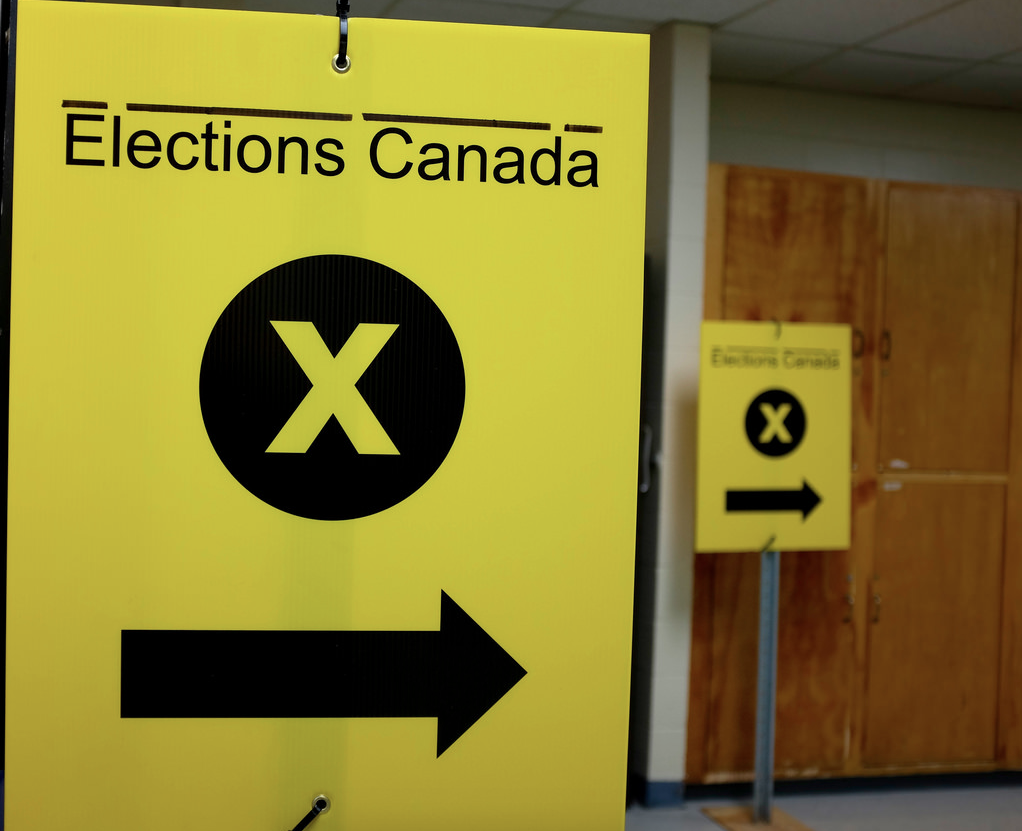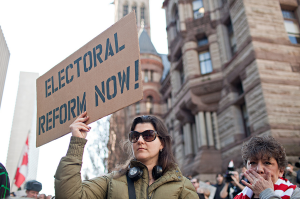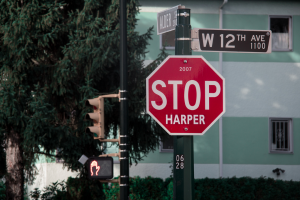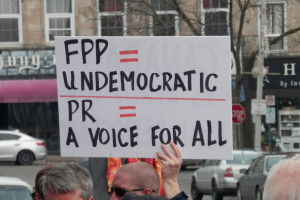Justin Trudeau, Heart Breaker: The False Promise of Electoral Reform
 https://flic.kr/p/zYyn2Y
https://flic.kr/p/zYyn2Y
“2015 will be the last election conducted under the current electoral process” were the words that came out of Justin Trudeau’s mouth when he hit the campaign trail in the summer of 2015. He promised that electoral reform would occur within the first 18 months if the Liberals were elected, but 14 months later the Liberal government is going back on their word and declaring that electoral reform is no longer a part of their agenda. Despite voicing support for electoral reform in the past, Trudeau is adhering to the “why would you change the system that voted you in” ideology that values the status quo over change – change that has the potential to strengthen Canada’s democratic processes. In the weeks following the breaking of the promise, there has been ample backlash. The government petition e-616, sponsored by Member of Parliament Nathan Cullen, calling for re-commitment to electoral reform has received over 125,000 signatures. The petition was created after Trudeau’s dismissive attitude on the topic of electoral reform in October during an interview with Le Devoir. In addition to this online form of solidarity, folks across Canada have been mobilizing to protest against the dismissal of electoral reform. The reasoning behind all this anger is understandable considering the potential that electoral reform has in strengthening Canada’s democratic integrity in order to truly represent all Canadians.

Our current system of single member plurality or ‘first past the post’ (FPTP) is a colonial legacy. This voting system was inherited and was one that suited the British’s needs during imperialism. Considering the fact that the nature of Canadian politics has changed significantly over the past 150 years, the way in which we form government ought to reflect these changes as well. FPTP inherently supports single party states as elections commonly result in “manufactured majorities.” This refers to the fact that the ruling party does not need to secure a majority of votes, only a plurality. While most people believe that our system runs under a “majority rules” discourse, FPTP actually propagates the idea of “winner takes all.” For example in the 2015 election, the Liberals won only 39.5% of the popular vote, yet secured a majority of seats in the House of Commons with 53% of the seats. Since the end of World War One, only 4 elections in Canada have resulted in a government that has secured at least 50.0% of the popular vote. The last time this happened was in 1984, when Brian Mulroney and his Conservative party was elected with 50.0% of the popular vote. Considering a few of the current issues that we have in Canadian democracy such as voter apathy, disproportionate representation in government, and false majorities, electoral reform can address many of Canada’s democratic deficits.

By contrasting two of the most common electoral systems, plurality systems and proportional representation, we can see the advantages and disadvantages of both. Plurality systems include first past the post, alternative vote, and two-round voting. All of these systems give seats in parliament to the candidates and parties who have achieved the plurality of votes. Alternative vote is the system that Trudeau has previously expressed interest towards. Alternative vote involves a ranked ballot where an absolute majority is achieved by dropping the candidates who get the least amount of votes and reallocating ranked votes. Two-round voting or ‘run off’ voting, which is used in France, is when and if a candidate is unable to garner the majority vote in the first round of voting, a second run-off election will be run with the top two candidates. Plurality systems are favoured due to their simplicity: however, it results in lost votes as the winner takes all. This mentality has incentivized strategic voting that distorts voter intentions. This was seen in the 2015 election, where there was a large “Anyone but Harper” movement. FPTP also popularizes tactics such as gerrymandering which is the redrawing of ridings to manipulate votes to ensure a plurality of support for a party. Due to the fact that Canada is so large, there is great deal of regionalism. While the results of elections show that they are clearly not homogeneous, the strong support for certain parties from different provinces show that there is a divide in political affiliation based on location. This illustrates the danger that is posed by regional parties that dominate in specific regions of Canada. Minorities are disenfranchised in stronghold regions, as they are unable to receive representation due to the fact that the structure of plurality voting systems bolsters the tyranny of the majority.
The second category of proportional representation is a system where the number of votes directly correlates with the number of seats. Proportional representation supports and amplifies the voices of minority groups that are otherwise dismissed or forgotten in pluralistic systems. It is a system that is predominantly utilized in European countries. Most proportional representation systems result in coalition governments as seen in Belgium and Switzerland. However, coalition governments are negatively perceived due to increased bureaucracy. While this system comes at the cost of efficiency and time in forming government, it is a small price to pay for proper representation as it is a cornerstone of liberal democracies. Coalition governments also promote greater consensus which involves more compromise for significant minority rights. Rather than a few political parties playing big tent politics and spreading themselves out thin to represent a larger portion of Canadians. Smaller parties offer representation of specific regional or marginalized interests that do not get prioritized in larger parties. Proportional representation systems such as list proportional representation and single non-transferable vote, allows for parties to have more control over the demographics their elected representatives. By zippering candidates on a ballot based on gender identity, ethnicity, and race, greater diversity and more proportional representation can be achieved in the legislature.
In 2015 there was a record number of 10 indigenous members of parliament elected into the office. While this increase is positive, this change must be continuously supported and promoted. This can be accomplished through the zippering system or creating allotted seats like New Zealand has to bolster greater Māori representation. Currently, 26% of the House of Commons’ seats are filled by women. In comparison, countries with proportional representation electoral systems see a greater representation of female members. For example, in Iceland’s 2016 election under the open-list system, 46% of the seats went to women and according to their Ministry for Foreign Affairs, they are now the “most equal Parliament in the world” without a quota system. Additionally, this election saw a voter turnout of 79% which is low for Iceland. In contrast the Canadian election in 2015 had a voter turnout of 68.3% which was the highest since 1993 election which had a 75.3% turnout. Since then, voter turnout has only been declining. With Canada at 131th in the world for voter turnout, many baby boomers tend to blame voter apathy on the millennials. However, in the last election, the age group with the most growth in turn out were new voters between the ages of 18-24. 57.1% of this group voted in comparison to 38.8% in 2011. This growth cannot be ignored in the dialogue on voter apathy, this suggests there are issues with the electoral system that promotes apathy. High turnout is also correlated with proportional representation as the nature of the system does not lead to lost votes at the magnitude of majoritarian systems, thus people feel more inclined to vote knowing that their vote counts.

Back to the Liberal government today, it is disappointing to see them go back on their word when there is so much potential for change and democratic growth with electoral reform. The Liberals spent at least 4.1 million dollars on the Special Committee’s Study on Electoral Reform (ERRE) created June 7th 2016. It was a non-partisan committee with representatives from each party in parliament that was proportional to the party distribution in the lower house. They sought to “identify and study viable alternatives to the current voting system” and engage with citizens through town halls. In June 2016, they travelled across the country, holding 57 town halls to consult Canadians and garner public opinion on a promise that they ended up breaking only months later. In the process of going back on his word, Trudeau threw rookie MP and previous Minister of Democratic Institutions Maryam Monsef under the bus by utilizing her as a scapegoat. During the town halls there was ongoing pressure on Monsef to disclose progress on democratic reform, however she continuously saying she didn’t want to undermine the work of the committee until the report was released on December 1st. After the release of the report of the ERRE the anger over the lack of substance resulted in the Liberal government introducing mydemocracy.ca, a platform seeking public opinion that was reminiscent of Buzzfeed quizzes but costs 250,000 dollars. . An issue with mydemocracy.ca was phrasing of the questions was focusing of the outcomes of the system rather than the systems themselves. This made it easy for the Liberal government to manipulate the questions to show how changes in the system could result in instability or unwanted outcomes. 50% of those who completed the quiz said they were somewhat satisfied about how democracy and 32% not satisfied there is a clear disappointment with the current electoral system. MP Nathan Cullen pointed out that many of the questions were unclear and thus, lead to unclear answers. With under 1.5% of eligible voters utilizing mydemocracy.ca it would be inappropriate to derive any concrete conclusions from the results, nevertheless some results of the quiz was utilized to justify rejecting electoral reform.
Due to the lack of clarity and “broad support”, the Liberal government suggests that a referendum is needed to engage Canadians with the topic of electoral reform. Maryam Monsef is now the Minister on the Status of Women and has been replaced by Karina Gould who has officially become the youngest appointed member of Cabinet. In the past week, Gould has been advocating first past the post which contrasts to Monsef’s opinion of the system as “antiquated”. Her new mandate is to “offer advice to Canada’s political parties and Elections Canada on best practices when it comes to cyber security.” which is a complete shift in the portfolio’s agenda. There is a source that states that the decision to abandon electoral reform was made early on in 2016. If the Liberal government never intended on implementing electoral reform, they should not have spent the resources that they did on the ERRE and mydemocracy.ca knowing their intentions and that these two government actions would inspire hope in those who wanted to see this change. Currently, there is a greater mobilization of support for electoral reform from citizens and within the House of Commons. In combination with the plethora of advantages and solutions that electoral reform offers to address democratic deficits in Canada, the Liberal government ought to revisit electoral reform.
